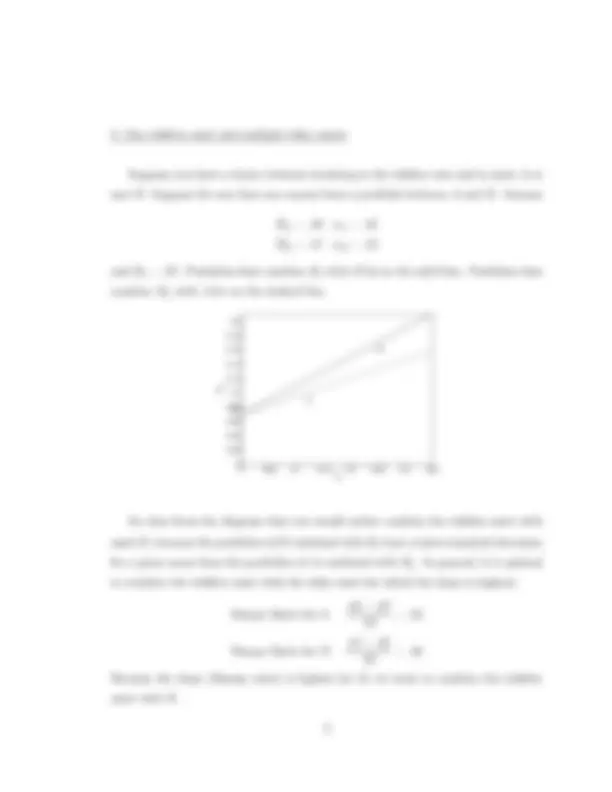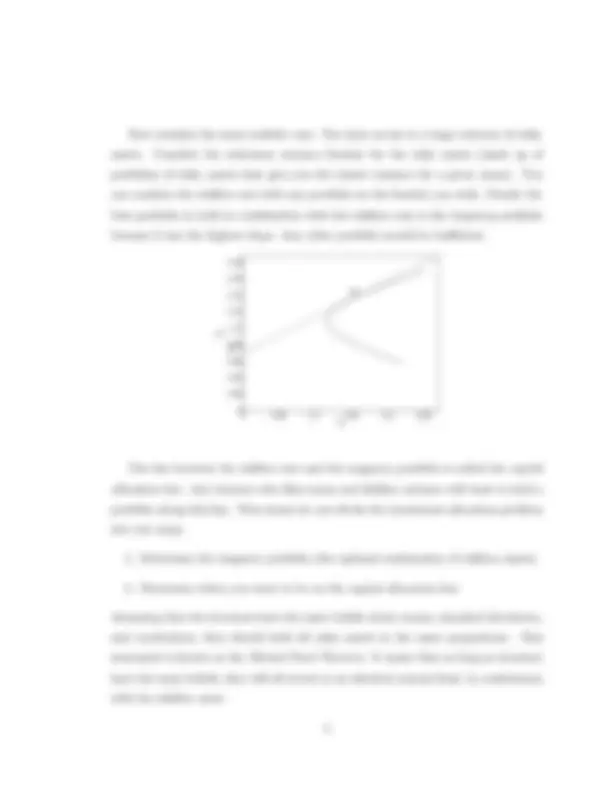




Study with the several resources on Docsity

Earn points by helping other students or get them with a premium plan


Prepare for your exams
Study with the several resources on Docsity

Earn points to download
Earn points by helping other students or get them with a premium plan
Community
Ask the community for help and clear up your study doubts
Discover the best universities in your country according to Docsity users
Free resources
Download our free guides on studying techniques, anxiety management strategies, and thesis advice from Docsity tutors
How the presence of a risk-free asset affects the set of possible portfolios. The analysis is conducted in two steps: one risk-free asset and one risky asset, and one risk-free asset and multiple risky assets. The concept of the sharpe ratio and its significance in portfolio optimization.
What you will learn
Typology: Slides
1 / 4

This page cannot be seen from the preview
Don't miss anything!



Handout 7: Optimal portfolios when there is a riskfree asset Corporate Finance, Sections 001 and 002
How does the set of possible portfolios change when you have access to a riskfree asset? We will conside the problem in two steps.
As we learned in our section on bond valuation, the riskfree asset is the zero-coupon bond whose maturity equals the length of your holding period. For concreteness, we will assume a one-year holding period, so the riskfree asset will be a one-year Treasury Bill.
Suppose the risky asset is a mutual fund. We will call this mutual fund “M”, and the riskfree asset “f”. The return on the mutual fund will therefore be called RM , while the return on the riskfree asset will be called Rf. Using our formulas for the mean and the variance, the mean of the portfolio that puts weight Xf in the riskfree asset and weight XM in the risky asset equals
R¯p = Xf Rf + XM R¯M
Note that Rf = R¯f because the riskfree asset is, by definition, without risk. Thus its return is always the same and equal to the mean. We also know that
Xf = 1 − XM
Substituting in, R¯p = (1 − XM )Rf + XM R¯M
σ^2 p = X f^2 σ^2 f + X M^2 σ M^2 + 2ρXM Xf σM σf
But σf = 0. Therefore:
σ p^2 = X M^2 σ M^2 σp = XM σM
Using this formula, we can show that the set of portfolios now form a straight line. Rearranging: XM = (^) σσp M Thus R¯p =
1 − (^) σσp M
Rf + (^) σσp M
And finally R¯p = Rf + σpR^ ¯M^ −^ Rf σM The slope of the line connecting the mutual fund to the riskfree asset equals R¯M σ^ −MRf and is called the Sharpe ratio.
(^00) 0.05 0.1 0.15 0.2 0.25 0.3 0.35 0.
σp
Rp Rf
M
Can we achieve a higher mean than R¯M? We can, by setting Xf < 0. Economi- cally, this corresponds to borrowing at the riskfree rate and investing the proceeds in the mutual fund.
Now consider the most realistic case. You have access to a large universe of risky assets. Consider the minimum variance frontier for the risky assets (made up of portfolios of risky assets that give you the lowest variance for a given mean). You can combine the riskfree rate with any portfolio on the frontier you wish. Clearly the best portfolio to hold in combination with the riskfree rate is the tangency portfolio because it has the highest slope. Any other portfolio would be inefficient.
(^00) 0.05 0.1 0.15 0.2 0.
Rf
M
σp
Rp
The line between the riskfree rate and the tangency portfolio is called the capital allocation line. Any investor who likes mean and dislikes variance will want to hold a portfolio along this line. This means we can divide the investment allocation problem into two steps.
Assuming that two investors have the same beliefs about means, standard deviations, and correlations, they should hold all risky assets in the same proportions. This statement is known as the Mutual Fund Theorem. It states that as long as investors have the same beliefs, they will all invest in an identical mutual fund, in combination with the riskfree asset.